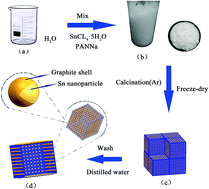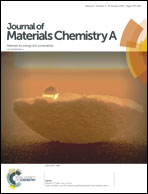Direct synthesis of 3D hierarchically porous carbon/Sn composites via in situ generated NaCl crystals as templates for potassium-ion batteries anode†
Abstract
It has been approved that embedding potassium ions into graphitic carbon interlayer is possible. The intercalation of potassium ions into graphite has been demonstrated feasible while the electrochemical performance of potassium ion battery (PIB) is still unsatisfying. Herein, an in situ formed NaCl serving as hierarchical templates and supporting the formation of 3D polymer–Sn complex is reported. The polymer–Sn complex is heat-treated to obtain a 3D Carbon/Sn network constructed by porous films. In particular, the large specific surface area of the composite and the Sn nanoparticles homogeneously embedded in 3D hierarchically porous carbon shells result in an excellent potassiation/depotassiation performance. Under the optimal conditions (650 °C), the 3D hierarchically porous carbon/Sn composite (3D-HPCS) as an anode material of PIBs demonstrates a high reversible capacity of 276.4 mA h g−1 at 50 mA g−1 (100 cycles) with coulombic efficiency of over 96%. This interesting method can provide new avenues to other high-capacity anode material systems that are subject to significant volume expansion.



 Please wait while we load your content...
Please wait while we load your content...